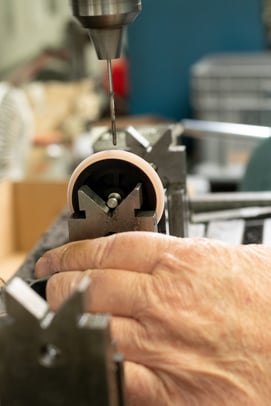Polyurethane Abrasion Resistance
Ever find yourself making repairs due to wear and tear? If so, you may need a material that is more resistant to abrasion. Abrasion resistance is a process in which a material can withstand surface wear caused by friction. This key physical property is often found in many applications experiencing frequent grinding, scratching, or rubbing away of a material's surface. In terms of abrasion resistance, thermoset polyurethanes often outperform other materials while at the same time being lighter than rubber or metal and will stronger than plastics. In this post, we will breakdown the importance of abrasion resistance and how you can use it in your product design.
What Is Abrasion Resistance
Abrasion resistance is a material's ability to withstand wear as it faces friction. The more friction an application encounters the quicker the part will deteriorate. The chemical composition of a material will determine how easily it wears when abraded. For example, thermosets tend to have a better abrasion resistance than thermoplastics due to their cross-linked chemical structure. If you want to learn more about thermosets versus thermoplastics, click here.
How to Measure Abrasion Resistance
Abrasion resistance values are usually measured by the percentage loss in mass. There are a variety of standardized methods to test abrasion resistance. This process typically involves either grinding, scratching or rubbing away a material's surface. Generally, results will differ from the actual wear a product will experience in an application but will provide comparative data to inform your design. A good method for controlled testing is Taber Abrasion. This test generally accelerates wear rates in a lab environment. The best way to test abrasion resistance, however, is to perform controlled field tests.
 Abrasion Resistance Compared to Other Materials
Abrasion Resistance Compared to Other Materials
As previously discussed, thermoset and thermoplastics differ in abrasion resistance. For example, many plastics tend to have weaker abrasion resistance than thermoset materials, causing plastics to wear at faster rates. Metals offer a wide range of abrasion resistant materials from soft aluminum to hard, stainless steel. Rubbers and other elastomers will also vary in abrasion resistance, traditionally being weaker than some metals and plastics. In applications that require high abrasion resistance, thermoset polyurethanes tend to demonstrate superior physical properties that will extend product life. If you want to learn morea bout how thermoset polyurethanes compare to plastics, metals and rubber, follow the links below.
How to Use Abrasion Resistance in Your Design
Abrasion resistance will be key a physical property for products that face friction in an operation. Although rubber, plastic and metals were often used for their durability, product designers are now adding thermoset polyurethanes into their designs for its abrasion resistant properties. Abrasion resistant materials are commonly found in applications that require high-wear performance, such as fitness & recreation, media handling, and industrial equipment to name a few.
Conclusion
Abrasion resistant properties offer designers the ability to improve their product's performance and service life. Based on design specifications, this physical property, among many others, can be tailored in polyurethane foam or solid materials. If you find abrasion resistance is a key performance trait in your design, this can easily be tailored by your manufacturer. For material assistance, complete our design tool, here, or download our material data sheets to learn how we can bring your design idea to life with our superior technologies.




